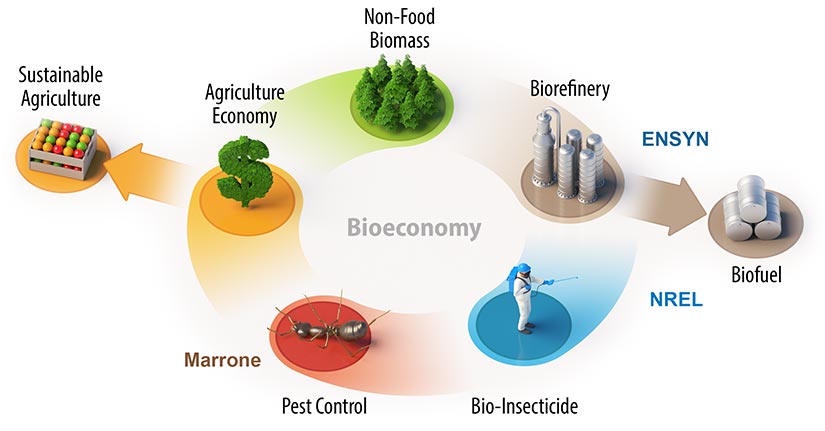Three Bio-Based Innovations Edge Closer to Market With Private-Public Funding

One of NREL’s TCF projects, illustrated here, connects biofuel and sustainable agriculture through a bioinsecticide that has a carbon footprint some 88% lower than current products.
A more sustainable farming sector, lower industrial emissions, more efficient biochemical production—National Renewable Energy Laboratory (NREL) scientists and industry partners expect sizable benefits from three new projects to commercialize bioinsecticides, enzymatic carbon dioxide (CO2) utilization, and cell-free biocatalysis.
Pulling a combined $750,000 from the U.S. Department of Energy's Technology Commercialization Fund (TCF) and matching funds from private industry, the three projects are designed to accelerate the adoption of innovative bioenergy technologies in the marketplace.
"Our TCF strategy is focused: connect our experts with American businesses and entrepreneurs to commercialize bio-based technologies that are better for our environment and economy," said Robert Baldwin, NREL principal scientist. "Such close partnerships are essential for moving energy innovations from the lab into the real world."
The three projects are among 16 TCF awards granted to NREL this year. By pairing DOE funding with private investment—a 50-50 cost share—the TCF allows NREL's researchers to focus on enabling energy technologies to achieve commercial impact.
Although NREL's three bioenergy projects appeal to different segments of the bioeconomy, together they underscore the compounding benefits of investing in bio-based technologies. Not only might they grow the bioeconomy, but they can also improve food security and help address climate change.
Here is a summary of NREL's bioenergy TCF projects:
Biorefinery economics often hinge on a company's ability to create chemical coproducts to offset production costs of low-carbon biofuels. A team of scientists will study the efficiency, process, and composition of bioinsecticides made from refinery outputs otherwise unsuited for making fuel. The team estimates such a bio-based insecticide could have a carbon footprint some 88% lower than incumbent products and be produced at a fraction of the cost.
Partners: Ensyn and Marrone Bio Innovations
Carbonic Anhydrases for Sustainable, Low-Energy CO2 Capture, Utilization, and Storage
Enzymes are a promising means of capturing, managing, and even upgrading CO2 released from power plants and heavy industry. Scientists are working to advance the development of carbonic anhydrase enzymes, one of the fastest enzymes in nature that catalyzes the conversion of CO2 into bicarbonate. By scaling the technology platform for producing carbonic anhydrase—and closely engaging technical and commercial partners—the team aims to promote the efficient and scalable capture of CO2.
Partner: Novozymes North America
More Affordable Enzymes for Cell-Free Biocatalysis
Microbes excel at converting the carbon in biomass into a range of biochemicals using dedicated enzymes. But scientists think such biochemical conversions could be more efficient if they are conducted outside of the microorganism, especially if the enzymes are specifically engineered for industrial use to produce target chemicals and products. A team of scientists will identify and develop the best enzymes and approaches for lowering the cost to implement such "cell-free" biocatalysis. Ultimately, the project could outline design principles for future cell-free chemical production pathways.
Partner: Invizyne Technologies
Learn more about NREL's bioenergy research.
Last Updated May 28, 2025
